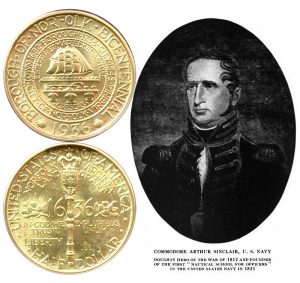Today, the Norfolk Commemorative Silver Half Dollar Coin remembers a naval battle in a nearby bay between the Adeline and the Lottery on March13, 1813.
From Battles of the United States, By Sea and Land by Henry Barton Dawson, published in 1858:
=====
The Schooner Adeline and the British Gunboats
Early in February, 1813, a strong naval force from the British fleet entered the Chesapeake.
After anchoring in Lynnhaven Bay, with the San Domingo and the Dragon, of seventy-four guns each, the Belvidera, Acaster, Maidstone, and two other frigates, and several smaller vessels, the bay was declared to be in a state of blockade, and considerable depredation was done, both on the adjacent shores and among the shipping which entered the harbor.
The smaller vessels, in addition to their duties as tenders, acted as decoys to entice such American vessels, as were ignorant of the blockade, within reach of the guns of the enemy’s ships within the bay; and several vessels were thus treacherously led to destruction.
On the thirteenth of March, 1813, three of these small vessels appeared off the anchorage-ground of a flotilla of United States gunboats, which was stationed a short distance above; and appeared desirous of drawing the latter from their moorings.
One of these small vessels was the Lottery, of Baltimore, a clipper-schooner, mounting six guns, which had been captured, after a desperate action, a short time previously, by the boats of the enemy’s squadron; and Commander Arthur Sinclair, who commanded the flotilla, immediately hoisted sail on the schooner Adeline, mounting two or three guns, and, in company with three gunboats, he got under weigh.
Notwithstanding the superiority of their force the enemy fled before him; and night coming on, at midnight Commander Sinclair anchored off Gwynn’s Island, with two of the gun boats—the third not being able to fetch in, having entered the Rappahannock.
Soon afterwards the Adeline was hailed by one of the schooners, and having answered, giving her name and character, Commander Sinclair repeated the question, without receiving a reply.
He was ordered, however, by the stranger, in the most peremptory manner, to send a boat on board the stranger, which he declined to do, and fired a musket ahead of the latter.
It was immediately answered with a broadside of round and grape shot, and with a discharge of small-arms from the stranger; when, in his turn, he gave her a broad side, and a severe engagement ensued.
After continuing the action twenty minutes the stranger was silenced; but the extreme darkness of the night prevented Commander Sinclair from seeing if she had surrendered, and, for the purpose of ascertaining her condition, he directed one of his gunboats which laid near her, to hail and make the inquiry.
Instead of answering, however, the stranger renewed the fire; and Commander Sinclair, notwithstanding he feared she was one of his “imprudent, headstrong countrymen,” was constrained to open a general fire from all the vessels under his command.
Twenty minutes more the action was continued—the uncertainty of the character and strength of his opponent adding to the interest which an engagement in the night naturally produces—and as the flashes of her guns broke, for a moment, the darkness of the night, the crowds of men on her deck indicated the general character of the stranger.
A second time her fire was suspended, and a second time Commander Sinclair, still uncertain of her nationality, ordered his command to discontinue the action.
In the most treacherous manner, however, no sooner had the American fire ceased than the stranger renewed the action; and, a third time, the broad side of the Adeline, seconded by the gunboats, poured their fire into her, in return.
This third engagement continued half an hour, when, a third time, the stranger suspended her fire.
Still anxious to avoid an unnecessary effusion of blood, although the bad faith of the stranger would have warranted a more severe course, Lieutenant Sinclair, a third time, ordered a discontinuance of the action; and an officer was immediately sent to take possession of her.
After a thorough search, he returned without finding her, and the mystery which surrounded the entire affair was increased by the uncertainty which prevailed respecting the fate of the stranger and her crew.
When daylight dispelled the gloom the floating fragments of the wreck—some of them ten or twelve feet long, torn from the hull of the vessel by the Adeline’e shot—appeared to give weight to the supposition that she had gone down, with all her crew; while an anchor, weighing about eight hundred pounds, and a large cable, which was secured, indicated a vessel of not less than two hundred tons burden.
It appeared, subsequently, that the unknown opponent of the Adeline was the clipper Lottery, before referred to; that, taking advantage of the night, she slipped away from the scene of her protracted struggle; that her injuries were so great that the most determined efforts of her crew to save her were unavailing; and that she sank before morning, before she could reach the anchorage of the fleet near New Point Comfort.
In this desperate conflict the Adeline and her consorts suffered but little injury; and of the crews, only one man was wounded.
=====
The Norfolk Commemorative Silver Half Dollar Coin shows with an artist’s image of Commodore Arthur Sinclair.
